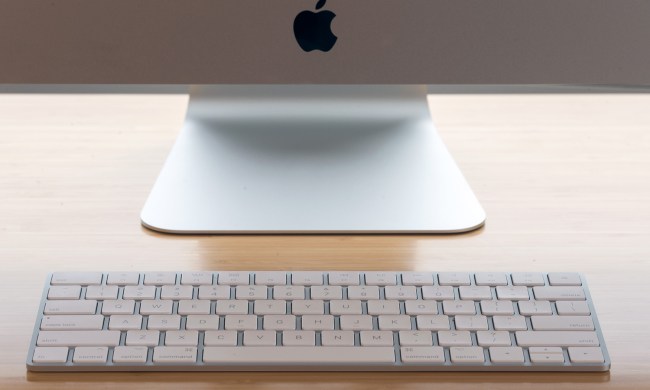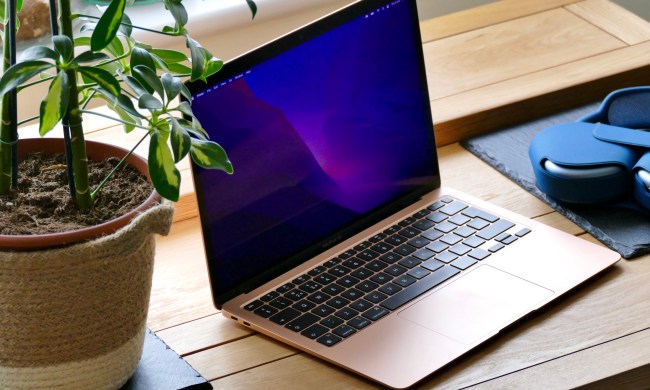- Superior design; quiet; relatively fast; built in iSight camera
- Only comes with an 8X SuperDrive; Lags in iPhoto
Summary
Following Apple’s master plan to move all computer systems to Intel processors by the end of 2006, Apple’s new 17″ iMac with Intel Core Duo processors replaces the 17″ G5-based iMac. Unlike the dramatic move from iBook to MacBook, there is no iMac redesign to fawn over. Apple continued using the highly praised and iconic all-in-one form factor of its powerful, yet compact desktop computer. The truly significant differences are internal – some subtle, some very evident.
Features and Design
The design of the 17″ Intel iMac is nearly identical to its last-revision G5 predecessor. As the old saying goes, “If it ain’t broke, don’t fix it.” Apple wisely stuck with the stunning all-in-one design of the iMac; a design that no other computer manufacturer has been able to duplicate or even approach; a design that had industrial designers and consumers all atwitter with excitement.
The 17″ iMac has a tiny footprint for a full-featured desktop – 114.24 square inches (maximum width times maximum depth). In comparison, a small form-factor eMachines or Gateway computer plus 17″ LCD screen has a clown-like footprint of 240 square inches or more. The iMac takes up less than half the space without sacrificing components, speed or style.
The front and sides of the iMac are surrounded in a thick, moderately scratch resistant, clear resin mold. The clear resin mold gives the iMac a gorgeous shine and protects the brilliant-white body from stains, mars and grubby fingerprints.
Even though most leading-edge computers on the market come with 16X DVD burners, Apple held back by supplying the 17″ iMac with an 8X SuperDrive. Of course, the 8X SuperDrive burns CDs, DVDs and even Dual-Layer DVDs quickly and stably and produces few or no faulty burns. In my opinion, Apple really should have gone all the way with a 16X dual-layer DVD burner.
The USB keyboard that comes with the Intel iMac is the same keyboard bundled with G5 iMacs and Power Mac desktop computers. The keys are spaced properly and the typing action is very smooth and responsive. It also matches the iMac perfectly, which is a huge plus for fashion conscious geeks.
Apple’s product page for the Intel iMac states that the Intel iMac has “Twice the Horsepower” of the fastest G5 iMac. Some people equate this statement with the idea that the Intel Core Duo architecture will make your computing experience twice as fast as the G5 architecture – everything from opening documents to editing photos and encoding movies should take half the time on the new desktops than it did on the old. While this logic works out in some cases (especially common benchmark tests), it cannot be applied universally.
Using the “horsepower” analogue, consider that the fastest purebred racehorses run upwards of 40 miles per hour. If you harnessed together two of the fastest horses in the world, would they go 80 miles per hour? Absolutely not. They would continue to run 40 miles per hour. Of course, if a single race horse was given a 300-pound load to carry – like processors are given heavy tasks to perform – that horse would be heavily burdened and would struggle to reach even half its potential. If the same two horses shared the 300-pound burden equally, each horse would be able to run significantly closer to its full potential. Similar logic applies to the Intel Core Duo processor. Some tasks, when shared by the two cores, allow the processor to be much more efficient and produce faster results.
There are many analogies that can be used to describe processing speeds, but the final and perhaps only significant argument is how a new processor affects your overall personal computing experience. If GarageBand used to open in 10 seconds and now it opens in 5, then you’ve experienced a doubling of speed. However if your everyday applications open only 10% faster – or in the case of Rosetta, 70% slower – then ‘twice the horsepower’ could be misleading.
Image Courtesy of Apple
Setup and Use
Setting up a new iMac easy. The box contains the iMac, power cord, keyboard, mouse, Front Row remote and OS X restore DVDs. From the moment I walked in the front door and saw my wife giving me the “You got another Mac?!” look, I had the computer set up and ready to go in under 2 minutes. I then spent 4 minutes explaining another Mac to my wife.
With a stopwatch started and power button pressed, the iMac ran through initial setups quickly. The ‘select language’ screen appeared in 53 seconds, as opposed to 1 minute 33 seconds with my iMac G5. My full name, address and other registration information were entered by 2 minutes 40 seconds. On the Intel-based iMac, OS X was set up and running by the time 5 minutes 10 seconds had passed.
Comparatively, the same setup process took 11 minutes for the Intel Mac Mini with Core Duo, 6 minutes 05 seconds for the MacBook Pro and 4 minutes 20 seconds for my beloved MacBook.
The basic pre-installed Universal applications like Address Book, iCal, Safari, Mail and iChat all opened in about 1 second. Popular free-ware programs such as Firefox, Camino and Adium, opened just as quickly. iWork’s word processor application, Pages, opens in 5 seconds on a loaded G5 iMac, whereas it opens in about 3 seconds on the Intel iMac.
Many people know that I am an avid photographer. The iPhoto/Adobe Bridge library on my G5 iMac has over 20,000 images from my Digital Rebel and Digital Rebel XT cameras. The ability of a computer to handle photo importing and manipulation is very important to me. Speed and absolute stability are critical. To that end, on the Intel iMac, an empty-library iPhoto opened in 1.5 seconds – slightly better than the 1.7 seconds it took to open on the new 2GHz MacBook. Importing 821 full-res 8 megapixel images into iPhoto took an excruciating 20 minutes 04 seconds. That’s an average of 41 pictures per minute. Without comparable data, 41 pictures per minute seems pretty good. On the Intel-based Mac Mini Core Duo, importing and default organization of 600 full-res 8 megapixel photos took only 7 minutes. That’s about 85 photos per minute! I was disappointed to see the Intel iMac import and arrange photos at half the speed of an Intel Mac Mini.
Rosetta-dependent applications like Word, Acrobat Professional and Photoshop CS2 open much slower than Universal applications, but they open faster on the iMac than they do on a loaded 1.5GHz G4 PowerBook.

The base configuration of the iMac line comes with 512MB of 667MHz DDR2 SDRAM (PC2-5300) on a single chip. This complement of 512MB RAM is just enough to let the iMac function well for all the basic applications – Mail, Safari, iPhoto, etc. The iMac will not operate at full potential with 512MB RAM, nor will it breeze through more intensive applications like Photoshop, Aperture, Final Cut, Logic Pro, etc. Most, if not all iMacs on display in Apple stores are set up with 1GB RAM. I highly recommend that anyone considering an Intel iMac for home or office use, does so with no less than 1GB of RAM. If Apple’s RAM is beyond your budget, Crucial.com has long been known as a very reliable source for top quality, Mac-compatible RAM. Crucial.com RAM can usually be purchased at a very significant savings.
The LCD screen on the iMac is simply wonderful. The 1440×900 resolution screen is powered by the ATI Radeon X1600 graphics with 128MB GDDR3 memory. It is perfect for all basic applications like iPhoto, iMovie HD, Photoshop and Aperture and even GPU-slamming applications like Final Cut Pro. The X1600 graphics card is reportedly suitable for serious gaming in OS X and in Windows XP Pro under Boot Camp.
Realistically, the 17″ screen may not be ideal for professional designers or photographers who generally require a lot more pixel real estate. If you plan to spend more than 1/3 of your time in Photoshop, Aperture, Illustrator or similar applications, the 20″ iMac is recommended. For general computing and even home media setups, the 17″ iMac is a very worthy solution. The 17″ iMac, with its compact profile, is also ideal for dorm rooms. I even used the 17″ iMac as a kitchen-based computer for watching my Emeril Lagasse TV shows while cooking! There are so many uses for a computer like the iMac!
In several recent reviews of Apple computers, I used the DVD movie Underworld to test the video card performance and image quality. When testing Underworld at native size on the 17″ iMac (about 50% of the screen), the playback was flawless and almost life-like. When playing the DVD full screen, I noticed some artifacts in dark or shadowy scenes. The colors remained rich and realistic at all playback sizes. After an hour of watching a pistol-toting, fang-flashing Kate Beckinsale whirl across the screen in Goth leather, I came to the conclusion that the Intel iMac’s DVD playback is astounding.
To test video encoding speeds, I often use the free DVD backup application “Handbrake”. (DVD backups should only be done within the scope of applicable laws.) On the last-rev 2.1GHz G5 iMac, Handbrake converts subject DVDs to default-setting MP4 movie files at an average of 23 frames per second. On the Intel iMac, Handbrake screams along at 65 frames per second, nearly three times faster! The final output quality is exactly the same. The excitement factor is way out there!

Conclusion
Having tested numerous PowerPC and Intel-based Macs in business, media and general-use scenarios, I feel confident saying that the 17″ Intel iMac is one of the better systems Apple has produced. It stays true to the sexy design that made millions fall in love with it. It runs silently. The screen is beautiful. The hardware and operating system are the most reliable around. It’s very fast and can handle most heavy workloads.
Because the design and exterior features of the 17″ Intel-based iMac are not rafter-shaking upgrades from the G5 iMac, it could be easy to discount how good this machine really is. Due to the lack of Universal Binaries for some of the most popular and critical programs, the Intel iMac dominates over the G5 iMac in most, but not all real-world speed tests. However, once all Mac programs are Universal Binaries, the Intel iMac will likely shred through speed tests with nary a bead of sweat.
Pros
- Virtually silent
- Super-bright screen
- iSight camera built-in
- Versatile all-in-one design
- Easy to relocate this desktop computer
- Excellent for small workspaces
Cons
- 8X SuperDrive should have been 16X
- Lagged in iPhoto import speed test





